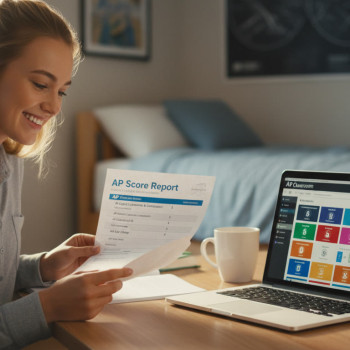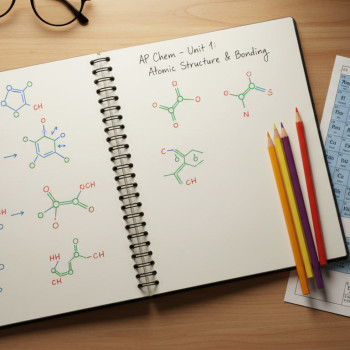Why a Weekly Time Budget Matters When You’re Doing IB HLs Plus APs
Balancing the intensity of IB Higher Level (HL) courses while taking one or two AP classes is a real challenge — but it’s also entirely manageable with a clear, flexible weekly time budget. This isn’t about packing every minute with study; it’s about prioritizing, protecting deep work, and leaving room for recovery so performance doesn’t come at the cost of wellbeing.
Think of a weekly time budget like a household budget: you plan where to spend the scarce resource (time) so you won’t get surprised at the end of the week. With IB HLs and APs, that scarce resource becomes even scarcer because HLs demand extended internal assessments, coursework and frequent assessments, while APs bring concentrated exam content and practice exams.

Who this guide is for
This blog is written for students (and their parents) who are juggling 1–3 IB HLs alongside one or two APs — a common combination for students aiming for both international recognition and college credit. You’ll find sample weekly schedules, a method for tailoring time budgets to your needs, and practical tips to sustain momentum through the year.
Quick Principles Before We Plan
- Prioritize high-leverage tasks: Assessments, IA deadlines, and practice exams beat passive re-reading.
- Protect deep work blocks: 60–90 minute uninterrupted blocks are where real learning happens.
- Build recovery into the plan: Sleep, short daily breaks, and at least one low-commitment evening help avoid burnout.
- Adjust weekly: Use a 20-minute Sunday review to update the next week’s budget after deadlines and quizzes shift.
- Quality over hours: Two focused hours can outdo three distracted ones. Use techniques like Pomodoro and active recall.
How to Calculate Your Weekly Time Budget
Start with available hours. If you sleep 8 hours/night, that leaves 16 hours/day or 112 hours/week. Subtract school hours, commute, meals, and essentials. Many students find 25–35 hours/week remain for study, activities, and rest. Here’s a basic way to allocate:
- Classroom & Homework (required): 12–18 hours/week (varies by school schedule and IB workload)
- HL Study & IA Work: 6–12 hours/week per HL (depending on proximity to deadlines)
- AP Study & Practice Exams: 3–6 hours/week per AP
- Revision / Active Recall: 3–6 hours/week total (spaced across subjects)
- Breaks, Wellness, Activities: 8–12 hours/week
These are starting points. If you have two HLs and one AP, expect different totals than if you have three HLs and two APs. The sample schedules below assume typical ranges and show trade-offs so you can adapt.
Sample Weekly Schedules (Realistic Templates)
Below are three practical templates you can plug into your calendar app or planner. Each sample assumes a Monday–Friday school week with some extracurriculars. Customize based on actual school timetables and upcoming assessment intensity.
Legend for the tables and samples
- HL1 / HL2 / HL3: Your IB Higher Level subjects.
- AP1 / AP2: The one or two AP courses you’re taking.
- IA / EE: Internal Assessment or Extended Essay blocks.
- Revision: Active recall sessions (flashcards, practice problems, exam-style questions).
Sample A — Balanced Load: 2 HLs + 1 AP (Moderate)
| Time | Mon | Tue | Wed | Thu | Fri | Sat | Sun |
|---|---|---|---|---|---|---|---|
| Before School | 30m Review (AP1) | 30m Review (HL1) | 30m Review (AP1) | 30m Review (HL2) | 30m Light Review | 1h Practice Test (AP1) | 20m Weekly Plan |
| After School | 90m HL1 Deep Work | 90m HL2 Deep Work | 60m Homework+IA | 90m AP1 Practice | 60m Catch-up | 2.5h Project / IA or Mock Exam | 2h Revision (mixed subjects) |
| Evening | 30–45m Active Recall | 30–45m Active Recall | Free / Social | 30–45m Active Recall | Free | Free | Wind-down + Sleep Prep |
Estimated weekly study: 18–24 hours. This plan keeps steady practice for AP while letting HLs get consistent deep work and IA time on weekends.
Sample B — High HL Focus: 3 HLs + 1 AP (Intensive)
| Category | Weekly Hours | Notes |
|---|---|---|
| Classroom & Homework | 14–18h | Higher due to HL coursework |
| HL Study / IA | 12–18h | Each HL requires sustained effort; cluster IA time |
| AP1 | 4–6h | Focus on practice tests and exam-style Qs |
| Revision | 3–4h | Spaced across the week |
| Wellbeing / Activities | 8–10h | Non-negotiable downtime |
Estimated weekly study: 38–56 hours (including classroom time). This one demands careful pacing: use IA sprints, and don’t let AP practice slip entirely — a weekly 60–90 minute AP session keeps content activation high.
Sample C — Lean Load: 2 HLs + 2 APs (Competitive Yet Sustainable)
This schedule is for a student who wants college credit for two APs while maintaining two HLs. The key is compartmentalized intensity: alternate AP focus weeks with HL focus weeks, and keep short daily maintenance for the subject not in focus.
- Daily maintenance: 20–30 minutes for the subject not in focus (flashcards, short problem sets).
- Alternate long blocks: One week emphasize AP1 and HL1; the next week AP2 and HL2.
- Weekend deep work: 3–4 hour sessions for project work, practice exams, or IA drafts.
How to Personalize: A 5-Step Mini Audit
Every student’s reality differs. Use this quick audit to tune any template to your life.
- List fixed commitments: School hours, clubs, sports, and necessary family responsibilities.
- Mark high-stake dates: IA deadlines, mock exams, AP practice test dates.
- Estimate time per subject: How many hours/week do you need to feel confident in each HL/AP? Be honest.
- Adjust for energy: Schedule heavy analytical work (math, chemistry) in your peak energy windows. Reserve lighter tasks (reading, review) for lower-energy times.
- Set one weekly non-negotiable: An evening that’s phone-free or an hour for a social activity keeps stamina high.
Study Strategies That Fit the Weekly Budget
It’s not just about hours — how you use them matters. Here are practical, high-yield strategies to maximize each study block.
- Active recall: Practice retrieving information without notes — flashcards, closed-book problem solving.
- Spaced repetition: Revisit topics on a 1-day, 3-day, 7-day cycle to move knowledge into long-term memory.
- Interleaving: Mix related subjects (e.g., HL Biology and AP Biology-style questions) to strengthen problem discrimination.
- Past-paper practice: For AP and IB exams, timed past paper practice is non-negotiable.
- Chunk IAs: Break IA or EE work into 45–90 minute sprints with concrete deliverables (outline, data analysis, draft paragraph).
Family and Parent Support: How to Help Without Hovering
Parents can be powerful partners in a student’s success. Here’s what helps most:
- Provide structure, not micromanagement: Encourage a weekly planning session rather than policing every study block.
- Ensure basic needs are met: Sleep, nutrition, and a regular exercise routine are performance multipliers.
- Normalize changes: Schedules should evolve with internal assessment cycles and mock exam timing.
- Offer practical help: Quiet spaces, healthy meals during heavy weekends, or arranging transport to a library for weekend mocks.
When to Consider Extra Help
If a student is consistently missing targets, losing sleep, or feeling anxious about deadlines, targeted support can make a decisive difference. That’s where tailored tutoring — such as Sparkl’s personalized tutoring — can fit naturally: focused 1-on-1 guidance to target weak areas, bespoke study plans that align with IA and AP timelines, and AI-driven insights to track progress across tasks. The right tutor helps a student get more efficient time-for-time and gives parents clarity on next steps.

Sample Weekly Time-Budget Worksheet (Fill-In)
| Item | Estimated Hours/Week | Actual Hours (Track) |
|---|---|---|
| Classroom & Assigned Homework | 12–18 | |
| HL Study / IA Work | 6–12 per HL | |
| AP Study / Practice Tests | 3–6 per AP | |
| Revision / Spaced Practice | 3–6 | |
| Extracurriculars / Sports | Variable | |
| Wellbeing / Rest | 8–12 |
Use this worksheet weekly: track actual hours and compare to estimates. If actual consistently exceeds estimate, either redistribute tasks or reduce commitments.
Common Pitfalls and How to Fix Them
- Pitfall — Overcommitting: Students often assume they can maintain three HLs and two APs without cutting other activities. Fix: Pull back one commitment or reduce club roles for one term.
- Pitfall — Marathon Studying: Cramming long nights before exams is inefficient. Fix: Break content into daily micro-sessions and schedule a full practice paper early to identify weak spots.
- Pitfall — Passive Review: Highlighting notes without retrieval is low yield. Fix: Convert highlighted sections into flashcards or practice questions.
- Pitfall — Ignoring Energy Rhythms: Forcing heavy math study late at night reduces retention. Fix: Time-match task difficulty to energy peaks.
How to Use Mocks and Mini-Deadlines
Mocks and timed practice are the calibration tools of any effective schedule. Treat them as data points — not final judgments. Schedule a mock for each AP and HL at least once per month during the school year. After each mock, spend one study block analyzing mistakes and building a micro-plan for the next week.
- Mock day: Simulate test conditions (timing, silence, no notes).
- Review day: Error log + targeted practice on the top three weakness areas uncovered.
- Recovery day: Light review and a social or athletic break to reset.
Final Tips: Making the Schedule Stick
- Put blocks in your calendar with reminders and treat them like appointments.
- Use a visible weekly plan (whiteboard or planner) and do a 20-minute weekly review every Sunday.
- Celebrate small wins: finished IA sections, improved mock scores, consistent sleep for a week.
- Leverage targeted support: short focused tutoring sessions (for example, Sparkl’s tailored 1-on-1 guidance) can provide focused strategies and keep momentum without huge time cost.
Wrap-Up: A Sustainable Path Forward
Balancing IB HLs and 1–2 APs is less about heroic all-nighters and more about a smart weekly time budget. Prioritize high-impact tasks, protect deep work blocks, and leave space for recovery. Use weekly audits and mock-driven adjustments to keep the plan honest and adaptive. When you need acceleration or an efficiency boost, targeted, personalized tutoring can help turn hours into measurable gains — not by doing the work for the student, but by sharpening what that work looks like.
Start this week: pick one sample that feels closest to your life, run it for two weeks, and tweak based on the audit. Small adjustments compound quickly — soon, the busy weeks will feel organized rather than overwhelming.
One Last Note to Parents and Students
Success in IB and AP is a marathon of smart, steady choices. With a realistic weekly time budget, intentional study strategies, and occasional targeted help, students build not only better scores but also learning habits that last. You’re not just planning for exams; you’re planning for sustainable success.


















No Comments
Leave a comment Cancel